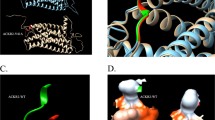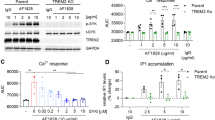Abstract
CC-chemokine ligand 2 (CCL2) is the major chemoattractant protein that recruits monocytes to sites of inflammation and increased expression of CCL2 is associated with numerous inflammatory diseases including human immunodeficiency virus-associated dementia (HIV-D). The −2578 guanine polymorphism in the CCL2 promoter has been associated with increased expression of CCL2 as well as pathogenesis of HIV-D; however, the molecular mechanism of regulation is unknown. We propose a molecular model for −2578 G-regulated CCL2 expression in astrocytes, which are major producers of CCL2 in the brain. The −2578 G polymorphism creates a consensus-binding site for the transcriptional regulator Prep1, which along with binding partner Pbx2, preferentially binds the −2578 G allele. CCL2 promoters harboring the G allele under unstimulated conditions exhibit a lower basal activity compared to the ancestral A allele. Upon interleukin-1β stimulation, Prep1/Pbx2 complexes maintain the ability to bind −2578 G alleles, yet transcription levels from promoters that harbor the A or G allele are equally activated, suggesting that the −2578 region does not influence CCL2 transcription under proinflammatory conditions. Therefore, promoters that harbor the −2578 G allele undergo a higher fold induction and by extension, individuals homozygous for −2578 G would be expected to exhibit hyper-responsive CCL2 phenotypes during periods of inflammation.
This is a preview of subscription content, access via your institution
Access options
Subscribe to this journal
Receive 6 digital issues and online access to articles
$119.00 per year
only $19.83 per issue
Buy this article
- Purchase on Springer Link
- Instant access to full article PDF
Prices may be subject to local taxes which are calculated during checkout




Similar content being viewed by others

References
Leonard EJ, Yoshimura T . Human monocyte chemoattractant protein-1 (MCP-1). Immunol Today 1990; 11: 97–101.
Conant K, Garzino-Demo A, Nath A, McArthur JC, Halliday W, Power C et al. Induction of monocyte chemoattractant protein-1 in HIV-1 Tat-stimulated astrocytes and elevation in AIDS dementia. Proc Natl Acad Sci USA 1998; 95: 3117–3121.
Fenoglio C, Galimberti D, Lovati C, Guidi I, Gatti A, Fogliarino S et al. MCP-1 in Alzheimer's disease patients: A-2518G polymorphism and serum levels. Neurobiol Aging 2004; 25: 1169–1173.
Craig MJ, Loberg RD . CCL2 (monocyte chemoattractant protein-1) in cancer bone metastases. Cancer Metastasis Rev 2006; 25: 611–619.
Galimberti D, Fenoglio C, Lovati C, Venturelli E, Guidi I, Corra B et al. Serum MCP-1 levels are increased in mild cognitive impairment and mild Alzheimer's disease. Neurobiol Aging 2006; 27: 1763–1768.
Libby P . Changing concepts of atherogenesis. J Intern Med 2000; 247: 349–358.
Mahad DJ, Ransohoff RM . The role of MCP-1 (CCL2) and CCR2 in multiple sclerosis and experimental autoimmune encephalomyelitis (EAE). Semin Immunol 2003; 15: 23–32.
Eugenin EA, D'Aversa TG, Lopez L, Calderon TM, Berman JW . MCP-1 (CCL2) protects human neurons and astrocytes from NMDA or HIV-tat-induced apoptosis. J Neurochem 2003; 85: 1299–1311.
Gonzalez E, Rovin BH, Sen L, Cooke G, Dhanda R, Mummidi S et al. HIV-1 infection and AIDS dementia are influenced by a mutant MCP-1 allele linked to increased monocyte infiltration of tissues and MCP-1 levels. Proc Natl Acad Sci USA 2002; 99: 13795–13800.
Dewald O, Zymek P, Winkelmann K, Koerting A, Ren G, Abou-Khamis T et al. CCL2/monocyte chemoattractant protein-1 regulates inflammatory responses critical to healing myocardial infarcts. Circ Res 2005; 96: 881–889.
Rovin BH, Lu L, Saxena R . A novel polymorphism in the MCP-1 gene regulatory region that influences MCP-1 expression. Biochem Biophys Res Commun 1999; 259: 344–348.
Muhlbauer M, Bosserhoff AK, Hartmann A, Thasler WE, Weiss TS, Herfarth H et al. A novel MCP-1 gene polymorphism is associated with hepatic MCP-1 expression and severity of HCV-related liver disease. Gastroenterology 2003; 125: 1085–1093.
Flores-Villanueva PO, Ruiz-Morales JA, Song CH, Flores LM, Jo EK, Montano M et al. A functional promoter polymorphism in monocyte chemoattractant protein-1 is associated with increased susceptibility to pulmonary tuberculosis. J Exp Med 2005; 202: 1649–1658.
Kruger B, Schroppel B, Ashkan R, Marder B, Zulke C, Murphy B et al. A monocyte chemoattractant protein-1 (MCP-1) polymorphism and outcome after renal transplantation. J Am Soc Nephrol 2002; 13: 2585–2589.
Tucci M, Barnes EV, Sobel ES, Croker BP, Segal MS, Reeves WH et al. Strong association of a functional polymorphism in the monocyte chemoattractant protein 1 promoter gene with lupus nephritis. Arthritis Rheum 2004; 50: 1842–1849.
Cho ML, Kim JY, Ko HJ, Kim YH, Kim WU, Cho CS et al. The MCP-1 promoter -2518 polymorphism in Behcet's disease: correlation between allele types, MCP-1 production and clinical symptoms among Korean patients. Autoimmunity 2004; 37: 77–80.
Szalai C, Kozma GT, Nagy A, Bojszko A, Krikovszky D, Szabo T et al. Polymorphism in the gene regulatory region of MCP-1 is associated with asthma susceptibility and severity. J Allergy Clin Immunol 2001; 108: 375–381.
Ahad MA, Missotten T, Abdallah A, Lympany PA, Lightman S . Polymorphisms of chemokine and chemokine receptor genes in idiopathic immune-mediated posterior segment uveitis. Mol Vis 2007; 13: 388–396.
Tabara Y, Kohara K, Yamamoto Y, Igase M, Nakura J, Kondo I et al. Polymorphism of the monocyte chemoattractant protein (MCP-1) gene is associated with the plasma level of MCP-1 but not with carotid intima-media thickness. Hypertens Res 2003; 26: 677–683.
Abraham S, Sawaya BE, Safak M, Batuman O, Khalili K, Amini S . Regulation of MCP-1 gene transcription by Smads and HIV-1 Tat in human glial cells. Virology 2003; 309: 196–202.
Abraham S, Sweet T, Sawaya BE, Rappaport J, Khalili K, Amini S . Cooperative interaction of C/EBP beta and Tat modulates MCP-1 gene transcription in astrocytes. J Neuroimmunol 2005; 160: 219–227.
Lim SP, Garzino-Demo A . The human immunodeficiency virus type 1 Tat protein up-regulates the promoter activity of the beta-chemokine monocyte chemoattractant protein 1 in the human astrocytoma cell line U-87 MG: role of SP-1, AP-1, and NF-kappaB consensus sites. J Virol 2000; 74: 1632–1640.
Chang CP, Jacobs Y, Nakamura T, Jenkins NA, Copeland NG, Cleary ML . Meis proteins are major in vivo DNA binding partners for wild-type but not chimeric Pbx proteins. Mol Cell Biol 1997; 17: 5679–5687.
Berthelsen J, Zappavigna V, Mavilio F, Blasi F . Prep1, a novel functional partner of Pbx proteins. EMBO J 1998; 17: 1423–1433.
Fognani C, Kilstrup-Nielsen C, Berthelsen J, Ferretti E, Zappavigna V, Blasi F . Characterization of PREP2, a paralog of PREP1, which defines a novel sub-family of the MEINOX TALE homeodomain transcription factors. Nucleic Acids Res 2002; 30: 2043–2051.
Ferretti E, Schulz H, Talarico D, Blasi F, Berthelsen J . The PBX-regulating protein PREP1 is present in different PBX-complexed forms in mouse. Mech Dev 1999; 83: 53–64.
Berthelsen J, Viggiano L, Schulz H, Ferretti E, Consalez GG, Rocchi M et al. PKNOX1, a gene encoding PREP1, a new regulator of Pbx activity, maps on human chromosome 21q22.3 and murine chromosome 17B/C. Genomics 1998; 47: 323–324.
Berthelsen J, Zappavigna V, Ferretti E, Mavilio F, Blasi F . The novel homeoprotein Prep1 modulates Pbx-Hox protein cooperativity. EMBO J 1998; 17: 1434–1445.
Goudet G, Delhalle S, Biemar F, Martial JA, Peers B . Functional and cooperative interactions between the homeodomain PDX1, Pbx, and Prep1 factors on the somatostatin promoter. J Biol Chem 1999; 274: 4067–4073.
Chen H, Rossier C, Nakamura Y, Lynn A, Chakravarti A, Antonarakis SE . Cloning of a novel homeobox-containing gene, PKNOX1, and mapping to human chromosome 21q22.3. Genomics 1997; 41: 193–200.
Gregory PA, Mackenzie PI . The homeodomain Pbx2-Prep1 complex modulates hepatocyte nuclear factor 1alpha-mediated activation of the UDP-glucuronosyltransferase 2B17 gene. Mol Pharmacol 2002; 62: 154–161.
Herzig S, Fuzesi L, Knepel W . Heterodimeric Pbx-Prep1 homeodomain protein binding to the glucagon gene restricting transcription in a cell type-dependent manner. J Biol Chem 2000; 275: 27989–27999.
Okada Y, Matsuura E, Nagai R, Sato T, Watanabe A, Morita I et al. PREP1, MEIS1 homolog protein, regulates PF4 gene expression. Biochem Biophys Res Commun 2003; 305: 155–159.
Chao SH, Walker JR, Chanda SK, Gray NS, Caldwell JS . Identification of homeodomain proteins, PBX1 and PREP1, involved in the transcription of murine leukemia virus. Mol Cell Biol 2003; 23: 831–841.
Rovin BH, Dickerson JA, Tan LC, Hebert CA . Activation of nuclear factor-kappa B correlates with MCP-1 expression by human mesangial cells. Kidney Int 1995; 48: 1263–1271.
Zhou ZH, Chaturvedi P, Han YL, Aras S, Li YS, Kolattukudy PE et al. IFN-gamma induction of the human monocyte chemoattractant protein (hMCP)-1 gene in astrocytoma cells: functional interaction between an IFN-gamma-activated site and a GC-rich element. J Immunol 1998; 160: 3908–3916.
Zhou ZH, Han Y, Wei T, Aras S, Chaturvedi P, Tyler S et al. Regulation of monocyte chemoattractant protein (MCP)-1 transcription by interferon-gamma (IFN-gamma) in human astrocytoma cells: postinduction refractory state of the gene, governed by its upstream elements. FASEB J 2001; 15: 383–392.
Saccani S, Pantano S, Natoli G . p38-Dependent marking of inflammatory genes for increased NF-kappa B recruitment. Nat Immunol 2002; 3: 69–75.
Teferedegne B, Green MR, Guo Z, Boss JM . Mechanism of action of a distal NF-kappaB-dependent enhancer. Mol Cell Biol 2006; 26: 5759–5770.
Ueda A, Ishigatsubo Y, Okubo T, Yoshimura T . Transcriptional regulation of the human monocyte chemoattractant protein-1 gene. Cooperation of two NF-kappaB sites and NF-kappaB/Rel subunit specificity. J Biol Chem 1997; 272: 31092–31099.
Ueda A, Okuda K, Ohno S, Shirai A, Igarashi T, Matsunaga K et al. NF-kappa B and Sp1 regulate transcription of the human monocyte chemoattractant protein-1 gene. J Immunol 1994; 153: 2052–2063.
Mori H, Kaneko Y, Narita I, Goto S, Saito N, Kondo D et al. Monocyte chemoattractant protein-1 A-2518G gene polymorphism and renal survival of Japanese patients with immunoglobulin A nephropathy. Clin Exp Nephrol 2005; 9: 297–303.
Simeoni E, Hoffmann MM, Winkelmann BR, Ruiz J, Fleury S, Boehm BO et al. Association between the A-2518G polymorphism in the monocyte chemoattractant protein-1 gene and insulin resistance and type 2 diabetes mellitus. Diabetologia 2004; 47: 1574–1580.
Glass JD, Fedor H, Wesselingh SL, McArthur JC . Immunocytochemical quantitation of human immunodeficiency virus in the brain: correlations with dementia. Ann Neurol 1995; 38: 755–762.
Gonzalez-Scarano F, Baltuch G . Microglia as mediators of inflammatory and degenerative diseases. Annu Rev Neurosci 1999; 22: 219–240.
Hou J, Major EO . Direct and indirect mechanisms of HIV-1 neuropathogenesis in the human central nervous system. Adv Exp Med Biol 2001; 493: 29–34.
Kaul M, Garden GA, Lipton SA . Pathways to neuronal injury and apoptosis in HIV-associated dementia. Nature 2001; 410: 988–994.
Zink WE, Zheng J, Persidsky Y, Poluektova L, Gendelman HE . The neuropathogenesis of HIV-1 infection. FEMS Immunol Med Microbiol 1999; 26: 233–241.
Letendre S, Marquie-Beck J, Singh KK, de Almeida S, Zimmerman J, Spector SA et al. The monocyte chemotactic protein-1 -2578G allele is associated with elevated MCP-1 concentrations in cerebrospinal fluid. J Neuroimmunol 2004; 157: 193–196.
Wright Jr EK, Clements JE, Barber SA . Sequence variation in the CC-chemokine ligand 2 promoter of pigtailed macaques is not associated with the incidence or severity of neuropathology in a simian immunodeficiency virus model of human immunodeficiency virus central nervous system disease. J Neurovirol 2006; 12: 411–419.
Acknowledgements
We thank the entire Retrovirus Laboratory at Johns Hopkins University School of Medicine for useful discussions, especially to Susan Follstaedt for her expertise with western blots, and Justyna Dudaronek and Kenneth Witwer for their expertise with siRNAs. This research was supported by NIH grants to JEC (nos. NS050028, NS47984 and MH70306).
Author information
Authors and Affiliations
Corresponding author
Rights and permissions
About this article
Cite this article
Wright, E., Page, S., Barber, S. et al. Prep1/Pbx2 complexes regulate CCL2 expression through the −2578 guanine polymorphism. Genes Immun 9, 419–430 (2008). https://doi.org/10.1038/gene.2008.33
Received:
Revised:
Accepted:
Published:
Issue Date:
DOI: https://doi.org/10.1038/gene.2008.33
Keywords
This article is cited by
-
Host gene-encoded severe lung TB: from genes to the potential pathways
Genes & Immunity (2012)
-
Prep1
AfCS-Nature Molecule Pages (2009)
-
Confirmation of differential binding of Interferon Regulatory Factor-1 (IRF-1) to the functional and HIV disease-influencing −2578 A/G polymorphism in CCL2
Genes & Immunity (2009)
-
Reply to Mummidi et al.
Genes & Immunity (2009)
-
Heme Oxygenase-1 microsatellite polymorphism and haplotypes are associated with the development of acute respiratory distress syndrome
Intensive Care Medicine (2009)


